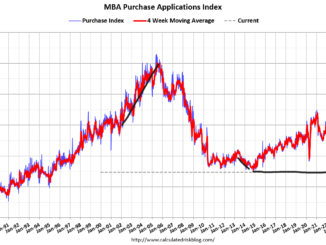
Housing demand has shifted more toward the new home market, Fannie Mae’s Economic and Strategic Research (ESR) Group noted in its May economic outlook.
While mortgage rates have pulled back modestly from their highs in early March, ongoing affordability constraints, a lack of inventory for sale, and the ongoing persistence of a “lock-in effect” – where existing homeowners with low mortgage rates are disincentivized to sell their homes – are likely to keep sales subdued for the remainder of the year, according to the ESR group.
“As such, housing demand has shifted further toward the new home market, bolstering builder optimism and the ESR Group’s single-family starts forecast,” the group said.
The housing starts forecast was revised upward by a larger (though still modest) amount, primarily due to a more positive outlook for near-term single-family starts.
New home sales jumped 9.6% in March and have generally trended upward since the fall of 2022. While Fannie Mae expects sales to soften somewhat later in the year, the new housing market appears more upbeat than it was at the start of the year.
Existing home sales have been largely in line with the ESR Group’s recent forecast of further gradual declines throughout the year, which were expected due to affordability constraints and tight existing home sales inventory of existing homes for sale.
Existing home sales pulled back in March by 2.4%, in line with Fannie Mae’s expectations, to an annualized pace of 4.40 million.
Pending home sales, which lead contract signings on average by 30-45 days, declined during that time by 5.2%, pointing to a further sales slowdown in April and May.
Fannie Mae projected total originations for 2023 to be $1.65 trillion, unchanged from its previous forecast of $1.66 trillion. For 2024, the agency anticipates volumes of $2.03 trillion, compared to its prior forecast of $2.02 trillion.
A modest upward revision to its purchase mortgage originations outlook — consistent with the home sales revision — was largely canceled out by a downward revision to refinance originations.
The ESR Group also reiterated its forecast for a modest recession at the start of the second half of the year.
“The usual channels through which monetary policy helps slow the economy may be disrupted, as evidenced by recent increases in new auto sales resulting from improving supply conditions and a more upbeat outlook from homebuilders,” according to the agency.
The timing, however, remains the principal outstanding question, as the Federal Reserve is likely to maintain tighter policy for longer if wage-related inflationary pressures do not subside, the group noted.
Duncan noted the possibility of a recession in April 2022, which he predicted would start in the first quarter of 2023.
Fannie Mae assumed that the ongoing debt ceiling impasse will be resolved in a manner that avoids a default by the U.S. government on its debt obligations. However, the GSE noted there is a small chance that a technical default or some other macro-relevant disruption to non-debt government payments could occur, which could impact its forecast.
“Housing remains exhibit number one for why we expect the recession to be modest. It continues to outperform our expectations, and we expect that its relative strength will help kickstart the economy into expanding again in 2024,” Doug Duncan, senior vice president and chief economist of Fannie Mae, said.



